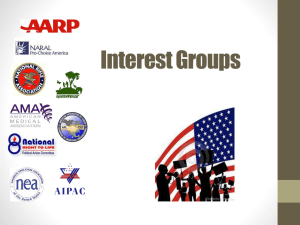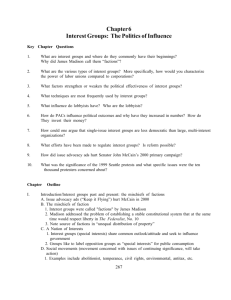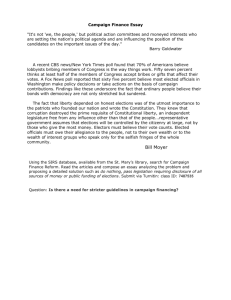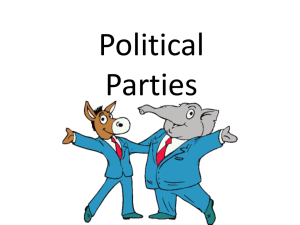AP GOVERNMENT CHAPTER 6:
advertisement
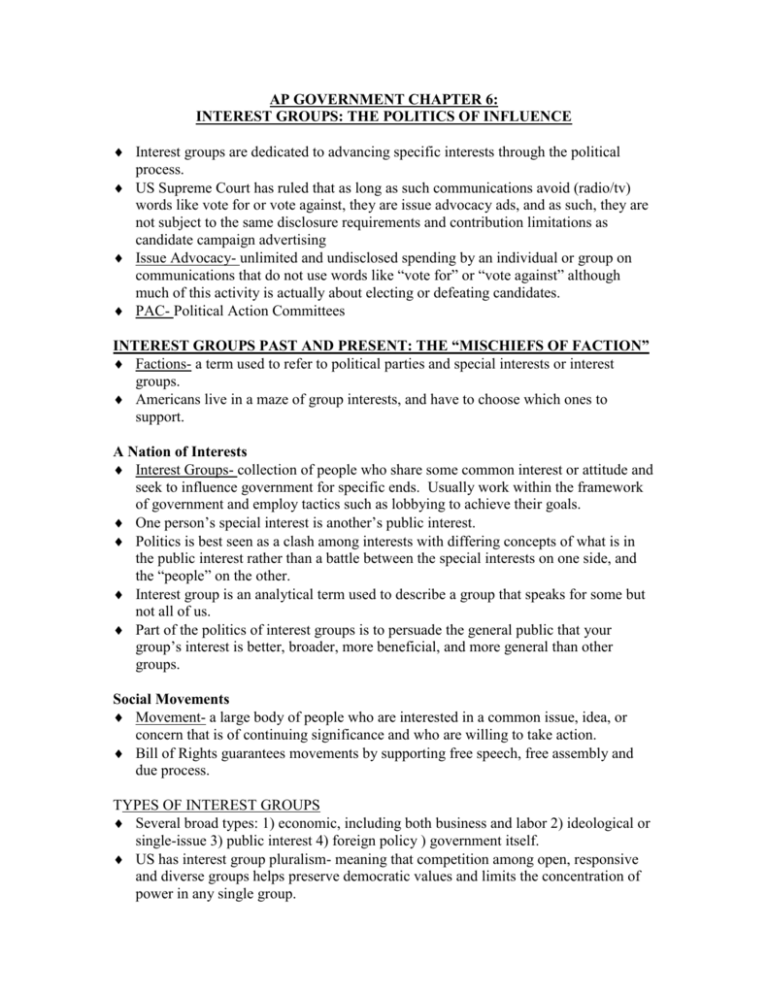
AP GOVERNMENT CHAPTER 6: INTEREST GROUPS: THE POLITICS OF INFLUENCE Interest groups are dedicated to advancing specific interests through the political process. US Supreme Court has ruled that as long as such communications avoid (radio/tv) words like vote for or vote against, they are issue advocacy ads, and as such, they are not subject to the same disclosure requirements and contribution limitations as candidate campaign advertising Issue Advocacy- unlimited and undisclosed spending by an individual or group on communications that do not use words like “vote for” or “vote against” although much of this activity is actually about electing or defeating candidates. PAC- Political Action Committees INTEREST GROUPS PAST AND PRESENT: THE “MISCHIEFS OF FACTION” Factions- a term used to refer to political parties and special interests or interest groups. Americans live in a maze of group interests, and have to choose which ones to support. A Nation of Interests Interest Groups- collection of people who share some common interest or attitude and seek to influence government for specific ends. Usually work within the framework of government and employ tactics such as lobbying to achieve their goals. One person’s special interest is another’s public interest. Politics is best seen as a clash among interests with differing concepts of what is in the public interest rather than a battle between the special interests on one side, and the “people” on the other. Interest group is an analytical term used to describe a group that speaks for some but not all of us. Part of the politics of interest groups is to persuade the general public that your group’s interest is better, broader, more beneficial, and more general than other groups. Social Movements Movement- a large body of people who are interested in a common issue, idea, or concern that is of continuing significance and who are willing to take action. Bill of Rights guarantees movements by supporting free speech, free assembly and due process. TYPES OF INTEREST GROUPS Several broad types: 1) economic, including both business and labor 2) ideological or single-issue 3) public interest 4) foreign policy ) government itself. US has interest group pluralism- meaning that competition among open, responsive and diverse groups helps preserve democratic values and limits the concentration of power in any single group. Most Americans are represented by a number of interest groups- some of which they are aware- others they are not. Economic Interest Groups Business- most familiar type is the large corporation. Exercise considerable political influence- corporate power and the implications of a changing domestic and global economy make business practices important political issues. Trade & Other Assoc.- businesses with similar interests in government regulations and other issues join together as trade associations. Largest type is Chamber of Commerce in the US Labor- labor unions are one of the most important groups representing workers. American work force is the least unionized of almost any industrial democracy. Cesar Chavez, Knights of Labor, AFL. Union membership is optional in states whose laws permit OPEN SHOP- where union membership cannot be required as a condition of employment. Closed Shop- union membership may be required as a condition of employment if most employees so vote. Free Rider- when a person benefits from the work or service of an organization like a union or even a public radio station without joining or contributing. AFL-CIO speaks for about 80% of unionized labor. Drop in the proportion of the work force belonging to unions is explained in part by the shift from an industrial to a service economy. NAFTA- North American Free Trade Agreement- fought heavily by labor unions “Paycheck Protection”- would require annual authorization by union members of portions of their dues to be used for political purposes. Unions have traditionally identified with the Democratic party, and have not enjoyed a close relationship with Republican administrations. Professional Associations- professional people have organized some of the strongest unions in the nation.Government, especially on the state level, regulates many professions. Professional associations also use the courts to pursue their own agenda. Ideological or Single-Issue Interest Groups Ideological groups are not driven by a desire to make money. Single-issue groups are highly motivated and see politics primarily as a means to pursue their one issue. Ex. NRA, ACLU Public Interest Groups Claim to promote the “Public Interest” and lobby Capitol Hill. Public Interest Research Groups (PIRG) founded by Nader are among the largest interest groups in the country. Tax-exempt public charity- specific type of public interest group, like Girl Scouts, American Heart Assoc, they must meet certain conditions, such as educational or philanthropic objectives to gain this status. Donations to these groups are tax deductible and are not required to disclose info about donors publicly. They cannot participate in elections or support candidates, nor can they benefit an individual or small group. Foreign Policy Interest Groups Groups organize to promote or oppose certain foreign policies. Council on Foreign Relations in New York City Exert pressure on members of Congress and the President to enact specific policies. Example- put pressure to influence US policy on South Africa and decision to abandon apartheid. National Association of Arab Americans lobbies for action in support of Arab causes. Efforts to secure a negotiated settlement between the Palestinians and Israel have meant that American interest groups on both sides of the dispute remain visible and important. Government & Government Employee Interest Groups Many cities and most states retain Washington lobbyists to represent them with state legislatures, Governors, etc. National Education Assoc. (NEA) has 2.7 million members- well-organized government employee group. Public employees are also important to organized labor, and are the fastest growing unions. Other Interest Groups Americans are often emotionally and financially involved in a variety of groups: veterans, nationality groups, religious, volunteer, etc. CHARACTERISTICS AND POWER OF INTEREST GROUPS Size & Resources Size is important to political power, the more members it speaks for, the more influence a group has. Perhaps even more important than size is the extent to which members are actively involved and fight for policy objectives. Organizations must provide incentives, material or otherwise, compelling enough to attract the potential free rider. Derive much of their strength from their negotiating position with corporations Members derive numerous benefits from joining large organizations. Spread- the extent to which membership is concentrated or dispersed. Interest groups also differ in the extent to which they preempt a policy area or share it with other groups. Groups also differ in their resources- which include money, volunteers, expertise, and reputation. Cohesiveness A mass membership organization is made up of 3 types of members: 1. A relatively small number of formal leaders who may hold full-time paid positions or devote much time, effort and money to the group’s activities. 2. People in tensely involved in the group who identify with the group’s aims, attend meetings, faithfully pay dues, and do a lot o the legwork 3. People who are members in name only, do not participate actively, and cannot be depended on to vote in elections as leadership wants. Organizational Structure- another factor in group cohesiveness- either formal organization, or local organizations that have joined together in a loose state or national federation in which they retain a measure of separate power and independence. Separation of powers found as well- the national assembly ratifies and establishes policy, an executive committee meets more frequently, etc. Leadership Leaders may either weld the various elements together or sharpen their disunity. Group leader must know when to lead followers and when to follow them. Techniques 1. Publicity & Mass Media Appeals- interest groups exploit the communications media- tv, radio, direct mail, to influence voters during elections and motivate constituents in-between elections. Businesses have an advantage in this area because they have the money and staff to use propaganda machinery. Email has become more and more popular way to contact people- fast, easy, cheap. 2. Mass M ailing- computerized and targeted mass mailing- computer permits easy storage of data and efficient mailing lists- they can easily produce personalized letters targeting specific groups. 3. Influence on Rule Making- government agencies publish proposed regulations in the Federal Register- and invite responses from all interested persons before the rules are finalized. www.access.gpo.gov many groups use the Register to stay alert of actions that may affect their group. Lobbyists prepare written responses to the proposed rules, draft alternative rules, and appear at the hearings to make their case.even if they fail to get what they want, they can fight the rules in court, or press for a reinterpretation when leadership changes. An interest group can seek to modify rules it does not like by pressuring Congress to change the legal mandate for the agency or have the agency’s budge reduced. 3. Litigation- when political channels closed to them they turn to the courts. Urban interests and environmental groups turned to the courts to influence the political agenda when they felt underrepresented. Amicus curiae briefs- “friend of the court” brief- filed by associations to get their interests in court in cases which they are not direct parties. 4. Election Activities- nearly all large organizations say they are nonpolitical, although almost all are politically involved in some way. What they usually mean is they are NONPARTISAN and they try to work through both parties. They want to be friendly with the winners, which often means they contribute to incumbents. Interest groups have generally invested more in one party or the other. Labor usually favors Democrats. Some organizations are prevented from taking a firm position because of the differing views of their members. Ideological groups target certain candidates, seeking to change a candidate’s position or, failing that, to influence voters to vote against that candidate. How Effective are interest groups? In general, the mass membership organizations’ power to mobilize their full strength in elections has been exaggerated in the press. More typically, there are too many cross-pressures operating in the pluralistic politics of the US or nay one group to assume a commanding role. 5. Forming a Political Party- another interest group strategy is to form a political party- organized less with the intent to win elections than to publicize a cause. Farmers have formed such parties- environmentalists do the same and are then forced to choose between supporting the Green party, or one of the two major parties- eventually taking some votes away form the Democrats. Minor parties rarely get more than 1 or 2% of the vote, yet this is enough for them to be accused of being “spoilers” for the major party candidate. 6. Cooperative Lobbying- like-minded groups often join together as cooperative groups. The larger the coalition, the greater the chance that members may divide over such issues as abortion. THE INFLUENCE OF LOBBYISTS the root in the word lobbyist refers to the lobby or hallway outside House and Senate chambers in the US capitol. Lobbying- is to seek to influence legislators and government officials and the policies they enact. Lobbyists perform useful functions for government. They provide information for the decision makers, help educate and mobilize public opinion, help prepare legislation and testify before legislative hearings, and they contribute a large share of the costs of campaigns. Who are the Lobbyists? Lobbyists- the employees of associations who try to influence policy decisions and positions in the executive and especially in the legislative branches of our government. They are experienced in the ways of government, often having worked for other groups or causes. After a few years in the administration, they are ready to make the move to lobbying. Moving from a government job to one with an interest group is quite common and called REVOLVING DOOR. It is illegal for former national government employees to directly lobby the agency they came from, but their contacts made during government service are helpful to interest groups. They help create networks of people who care about certain issue. Iron Triangles- mutually dependent relationships among interest groups, congressional committees and subcommittees, and the government agencies that share a common policy concern. Become strong relationships and the iron triangle becomes very powerful and a sort of subgovernment forms. Legal and political skills, along with specialized knowledge have become crucial to policy making. Elected representatives increasingly depend on their staffs for guidance, and these issue specialists know more about each specific topic. Interest groups and lobbyists play a vital role in creating these issue networks and providing info. What do Lobbyists Do? One limit on their power is the competition among interest groups. Rarely does any one group have a policy area all to itself. To members of Congress, the single most important thing lobbyists provide is money for their next reelection campaign. Money from interest groups has become instrumental in the driving need among incumbents. They also provide volunteers for campaigns. “Third House”- lobbyists seen as a third house of Congress, where they represent the people based on interests and money. Small but important groups can sometimes get representation in the third house when they cannot get it in the other two. Interest groups provide another essential commodity to legislators: information of two important types: political and substantive. Political information- provided by lobbyists includes such matters as who supports or opposes legislation and how strongly they feel. Substantive Information- the impact of proposed laws. MONEY AND POLITICS Political Action Committee (PAC)- the political arm of an interest group that is legally entitled to raise funds on a voluntary basis from members, stockholders, or employees in order to contribute funds to favored candidates or political parties. Packs give money and other political aid to politicians and persuade officeholders to act or vote “the right way” on issues. The Growth of PACs 1970s brought a near revolution in the role and influence of PACs as the result of reforms intended to reduce the influence of money in elections. Number of PACs increased from 150 to nearly 4000 today. Corporations and trade associations contribute the most to its growth- Labor PACs are less than 10%. How PACs invest their money Their main influence lies in their capacity to contribute money to candidates- they need a lot of $ to run a campaign, it is not uncommon for a House candidate to spend more than $1M and Senators several times more. As PACs contribute more, their influence grows. What counts is not only the amounts they give, but also to whom they give. PACs give not only to the majority party, but to the minority party as well, knowing that today’s minority may be tomorrow’s majority. Federal Election Campaign Act of 1971- amended in 20 02, limits PACs to $5000 per election and $10, 000 per election cycle (primary and general election) Individuals have a limit of $4,000 per candidate per election cycle. PACs have found some creative ways around this limit Bundling- where PACs collect contributions from like-minded individuals (limited to $2000 ea) and present them to a candidate as a bundle- increasing their influence. Soft Money – money raised in unlimited amounts by political parties for partybuilding purposes. Now largely illegal except for limited contributions to state and local parties for voter registration. Soft Money in 2002 election www.crp.org The Effectiveness of PACs PACs give more money to incumbents than challengers who face real difficulties trying to fund their campaigns. Campaign Finance Reform Law in 2002 doubled the individual contribution limit and thus reduced the difference in PAC contributions over individual contributions from 2 1/2 to 1. Soft money contributions were banned in the campaign finance reform of 2002. In highly competitive races, interest groups mount issue advocacy campaigns to help elect or defeat candidates- they include all modes of communication with voters. 2002 Campaign finance reform banned unions and corporations from using treasury funds to pay for election ads in the month before a primary and two months before a general election. Also expands the definition of an election ad to include ads that mention the candidate by name, show the image or likeness of the candidate, or mention the election. Law also requires greater disclosure of groups involved in this activity “When politicians start to see a dollar sign behind every vote, those other factors sometimes weighed during governance, like the public good and equal access to government, become less and less important.” Often times, how much campaign contributions affect election outcomes affect whether or not a politician will be able to “remember” their financial donors in the end. Much depends on the context in which money is given and received- there is a significant relationship between the frequency of lobbying contacts and favorable treatment in the Ways and Means House committees. CURING THE MISCHIEFS OF FACTION- TWO CENTURIES LATER Today there is a varied weapon of group influence, deep involvement of interest groups in the electoral process, and a vast number of lobbyists in Washington and state capitols. One main argument against factions is that people are not represented equally. Also, some groups are better organized and better financed, allowing them a decided advantage over more general groups. Another problem is the existence of a multiplicity of interests leading to inefficiency. Propensity of interest groups to support incumbents in elections increases their advantage. The ability of interest groups to supply needed and accurate information to government officials increases their power. Which single-issue groups reflect too narrow of an interest? How can interest groups be regulated in a way that does not threaten their constitutional liberties? Federal & State Regulation Americans seek to regulate lobbying in general and political money in particular. Credit mobilier construction company, Teapot Dome Scandal, example of corruption. 1971- Federal Election Campaign Act (FECA) established reporting or disclosure requirements or all candidates for the US House of Reps, the Senate, and the presidency, as well as their political parties and campaign committees. Also required disclosure of the amounts spent to influence federal elections by others, including individuals and PACs. Created a voluntary checkoff on federal income tax forms for people to donate to campaigns. Some states, including Wisconsin, provide for public financing of state offices and state legislative races. Lobbying Disclosure Act of 1995- expanded the definition of a lobbyist and included part-time lobbyists. Interest groups desiring to engage in issue advocacy can continue to do so, behind the names of other never-heard of groups. Issue advocacy ads permit the interest group to circumvent contribution limits and some of the disclosure requirements imposed on candidates. 2002 CAMPAIGN FINANCE REFORMS 2000 election, collapse of Enron, spurred on the movement. Bipartisan Campaign Reform Act of 2002- banned most forms of soft money- leaving individuals and PACs able to contribute $10,000 to state or local party committees, raised the individual contribution limits, restricted broadcast issue advocacy before primary and general elections. Quid Pro Quo- something given with the expectation of receiving something in return. PG. 156-158




